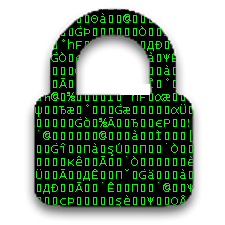Difference between revisions of "Encryption"
Joe90862nj (talk | contribs) (edit for clarity Joe Tag) |
Joe90862nj (talk | contribs) (edit by Joe Tag) |
||
| Line 45: | Line 45: | ||
[[Gilbert Vernam]]. | [[Gilbert Vernam]]. | ||
{{SMWDocs}} | {{SMWDocs}} | ||
| + | ==Tools== | ||
| + | TrueCrypt; OpenPGP (GnuPG project); Tor and Tails, Luks and Encryption Wizard, among others. | ||
==References== | ==References== | ||
{{reflist}} | {{reflist}} | ||
Revision as of 14:41, 11 August 2016
(technology) | |
|---|---|
 | |
| Interest of | • Laura Halminen • Bruce Schneier |
| A process of obscuring information so that it can only be read by a selected number of recipients. | |
Encryption is the process of changing data from an understandable form into a scrambled form. The inverse process, of restoring the original data from the encrypted forms referred to as decryption (or deciphering).
Contents
Official narrative
The commercially-controlled media regularly have stories suggesting that a battle is ongoing between intelligence agencies and the technology companies, about the use of encryption, with the former seeking the ability to decrypt any message, and the latter attempting to protect their users' data from being read. This may well be mere smoke and mirrors to obscure the reality that a large proportion of all large companies' encryption products are cracked, whether by design or by faulty programming.
Origins
Encryption has 3 to 5 parts: "M" a MESSAGE; "K" a Key to encrypt a message, and "C" the result resulting encrypted data.
Part 4 and part 5 may be 2 additional keys that interact with other keys.
Classic systems involved pencil and paper methods.
One group of systems used letter tables and rules to change a text letter into a ciphered letter. Another method used a
known rule to convert letters to numbers, and then performing an addition function with a key, to produce a ciphered text.
Yet another example of an encryption method was to use a dictionary as a codebook, assigning words to the combination of page number, column, and entry of that column. See codebook; dictionary code. An illustrated example is generally known as the One Time Key method; versions being the One-Time Pad, One-time tape .
Keys
By analogy with doors, a "key" is needed to provide access to encrypted data.
Legal status
The deep state appears to be trying to use the "war on terror" as an excuse to outlaw encryption, and if not, to control it. This agenda is regularly promoted stepwise after "terrorist" attacks. It is proceeding at different rates in different countries.
Australia
Under the 2015 Defence Trade Controls Act, which came into force in 2016, it may be illegal to learn about encryption in Australia.[1]
USA
In April 2016, a draft of a law called the Compliance with Court Orders Act were leaked, which suggested broad plans to make encryption illegal. The Business Software Alliance came out against the Burr-Feinstein bill, saying it "strongly urges" the US Congress to think again.[2]
Current concerns
The good professionals know, that encryption must be in the hands of end-users; including "operators" and "actors" in the intelligence definition.[citation needed] Many people believe that no sovereign government, police agency, criminal or terrorist group needs to know their plans immediately; and that when proper encryption is employed, clear data may be discovered only after 2 weeks to 10 years of continuous cryptanalytic processing. Some[Who?] suggest key sizes of 48 characters ( 384 bits) to 64 characters ( 512 bits) for a single message.
Vocabulary
CODING has several meanings: 1) To program, "to code"; 2) To convert and change data from one form into another. See also codebook . regarding CODE BOOKs. In the context of what is known as secure voice analog speech is changed, converted into a digital stream or digital buffer ie: "Code Excited Linear Predictive coding, CELP" . This plain voice, is then encrypted by boolean operations; see XOR. Secure voice systems like the STU-III, STE, vIPer and Hannibal are quite complex.
Digital Encryption dates to 1919 at AT&T Federal Labs in the financial district of New York City. A pioneer in this work was Gilbert Vernam.
An example
| Page name | Description |
|---|---|
| TrueCrypt | Widely praised disk encryption software, abruptly discontinued in 2015. Version 7.1a (not 7.2) is the latest fully functional version. |
Related Quotations
| Page | Quote | Author | Date |
|---|---|---|---|
| Roger Dingledine | “The United States government can’t simply run an anonymity system for everybody and then use it themselves only. Because then every time a connection came from it people would say, “Oh, it’s another CIA agent.” If those are the only people using the network.”” | Roger Dingledine | 2004 |
| Rod Rosenstein | “Responsible encryption is achievable. Responsible encryption can involve effective, secure encryption that allows access only with judicial authorization. Such encryption already exists.” | Rod Rosenstein | 10 October 2017 |
| Malcolm Turnbull | “The laws of Australia prevail in Australia, I can assure you of that. The laws of mathematics are very commendable but the only law that applies in Australia is the law of Australia.” | Malcolm Turnbull | 14 July 2017 |
| Christopher Wray | <nowiki>“To put it mildly, this [[[encryption]]] is a huge, huge problem. It impacts investigations across the board — narcotics, human trafficking, counterterrorism, counterintelligence, gangs, organized crime, child exploitation.”</nowiki> | Christopher Wray | 2017 |
An official example
| Name |
|---|
| Signal Messenger |
Tools
TrueCrypt; OpenPGP (GnuPG project); Tor and Tails, Luks and Encryption Wizard, among others.
References
http://www.jproc.ca/crypto/otfp_otlp.html
Texts:
CLARK, Robert M; Intelligence Collection; (c)2014 CQ Press; pp56--58.